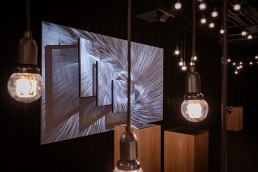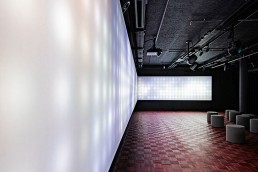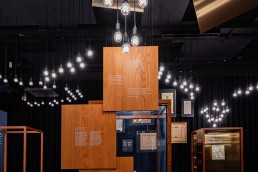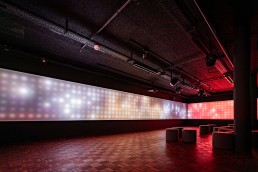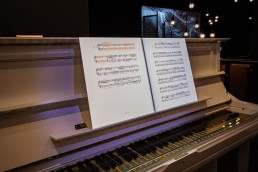This website uses cookies so that we can provide you with the best user experience possible. Cookie information is stored in your browser and performs functions such as recognising you when you return to our website and helping our team to understand which sections of the website you find most interesting and useful.
Carl Nielsen Museum
ProjectCarl Nielsen MuseumLocationOdense, DenmarkArchitectEVENT Communication, LondonInstallerStouenborg ApSSubmitted byStouenborg ApS
This exhibition, delving into Carl Nielsen’s music and life, has placed sound at the centre as the museum had to reemerge in Odense city. The purpose of the exhibition was to explore Nielsen’s inspirations and music, resulting in a well-balanced combination of existing recordings of Nielsen’s works and uniquely recorded sound pieces for the museum recorded by the Odense Symphony Orchestra.
A crucial decision was the choice of an innovative speaker system capable of activating sound sequences in specific areas while dampening the sound level in adjacent areas. Therefore, the integration of PIR sensors, triggered when visitors approach specific areas, was essential to make it possible. The atmospheric sound that accompanies and envelops the visitors is created by an immersive surround speaker system formed by over 100 speakers placed on the sides and ceiling.
In addition to the atmospheric sound, visitors have the opportunity to acquire information through headphones placed at various listening stations around the exhibition. These headphones deliver sound to an information screen, touch screen, or other visual element.
This innovative approach to the sound experience in the exhibition not only enhances visitor interaction but also immerses them in Carl Nielsen’s world in a new and engaging way.
Embedded in the walls are lamp bulbs in colours featured in the exhibition. These lamps are programmed to synchronise with the sound waves, creating a pulsating effect. When properly configured, they contribute to an enchanting and emotionally charged atmosphere that enhances the overall experience for visitors. Without careful calibration of colours, intensity, and speed, however, the effect can become distracting. Nevertheless, with the right adjustments, it transforms into a captivating and aesthetically pleasing journey for all who visit the exhibition.
In addition to contributing to the atmospheric experience, the lighting throughout the exhibition also serves as a subtle transition and guide for visitors from room to room. The numerous light sources are adjusted to guide the way by regulating the intensity, for example, when a film or other visual element concludes, signalling it’s time for the visitor to continue their journey.
There are also fixed locations in the exhibition where a piece of music is played, either in the room or through headphones, and where the light, again, in harmony with the sound, plays an important role in the narrative. Here, the light is a co-creator of mood and atmosphere, setting the stage for the musical experience and amplifying the feeling of being deeply immersed in Carl Nielsen’s world. This symbiosis between sound and light contributes to a more nuanced and engaging exhibition experience, where visitors can feel completely enveloped in Nielsen’s musical universe.
The exhibition is enriched with a variety of visual effects that not only complement the sound and lighting effects but also evoke emotions and inform visitors about Carl Nielsen’s life and music. Throughout different sections of the exhibition, various listening stations are set up where visitors can acquire information via information screens, touchscreens, and projections on different surfaces. A notable example is a three-sided video display where a projector casts images onto a grid, creating a partially transparent surface. This projection is designed in chronological order with a graphic timeline in the corner, allowing visitors to jump in at any point and still follow the narrative.
One of the most impressive visual elements is the self-playing Yamaha piano, where a composition is recorded with precise keystrokes and programmed to synchronise perfectly with the music playing in the accompanying headphones. Additionally, there is a screen displaying the moving notes the piano is playing, thus completing the experience of the self-playing piano. The piano not only provides a visual and auditory delight but also offers visitors an interactive experience that goes beyond the typical museum visit.
These visual elements are not merely decorative but are carefully integrated into the exhibition’s narrative structure and convey the story of Carl Nielsen engagingly and interactively. They contribute to creating a holistic experience that appeals to both the senses and intellect of the visitors, making the museum a vibrant and unforgettable space for culture enthusiasts and music lovers.
The Carl Nielsen exhibition spans over 400 square meters across two floors, divided into three distinct areas. Visitors embark on the Carl Nielsens journey starting with Area Number 1 Calibration, transitioning to Area Number 2 Exploration, and culminating in the immersive experience of Area Number 3 Immersion.
The museum’s size itself was a challenge. With Carl Nielsen’s music at its core, orchestrating the seamless integration of multiple sounds and compositions within a relatively confined space demanded innovative solutions. This necessitated the creation of numerous sonic elements within a singular environment, adding complexity to the project.
In response to this challenge, adjustments were made post-installation. A logical system was implemented to ensure that if audio was triggered and played in one area, neighbouring sections would remain silent, enhancing the visitor’s experience. This required meticulous attention to detail to ensure the stability and reliability of the system, ensuring seamless operation day in and day out.
Crafting a system capable of supporting this dynamic interplay of audio while maintaining stability presented significant technical hurdles. However, through careful planning and collaboration, the team overcame these obstacles, ultimately delivering an immersive and cohesive experience that celebrates the legacy of Carl Nielsen’s music.
The Carl Nielsen Museum stands as a testament to the seamless fusion of physical relics and digital interfaces, enveloped within an ambience of immersive audio and atmospheric lighting. From its inception, the museum’s team was steadfast in its commitment to making Nielsen’s music and world the focal point of the visitor’s journey.
Leading the charge in bringing this vision to life, Stouenborg took on the mantle of the main contractor, collaborating closely with all stakeholders involved in the project. The museum unfolds across three distinct sections, each meticulously crafted to engage the senses and delve into the depths of Nielsen’s inspirations, music, and creative prowess.
At the heart of the exhibition lies a captivating interplay of light and sound, where existing recordings of Nielsen’s compositions intertwine with pieces specially recorded for the museum. A notable highlight is the inclusion of a self-playing Yamaha piano, intricately synchronised to a composition, allowing visitors to marvel at its performance while immersing themselves in the accompanying music through headphones and following the score on a monitor.
Moreover, the museum boasts enclosed sound experiences, facilitated by advanced speaker systems, carefully chosen lighting cues, informative screens, and projection techniques that weave narratives and evoke emotions. The narrative of Nielsen’s artistic development, along with the technical effects in the exhibition, together enhance the ambience. Everything in the exhibition is carefully crafted to captivate and educate the visitors, and the interplay between the narrative of Nielsen’s artistic evolution and the technical effects helps to improve its conveyance.
Ease of use and adaptability were paramount considerations in the design and execution of the museum’s installations. The control systems are intuitively designed, offering visitors a seamless and user-friendly experience while also accommodating diverse needs and events that may unfold within the museum’s walls.
In essence, the Carl Nielsen Museum transcends traditional museum experiences, offering visitors a multi-sensory journey through the life and works of one of Denmark’s most celebrated composers. Through a delicate balance of physical artefacts, cutting-edge technology, and immersive storytelling, the exhibition serves as an inspiration for both music enthusiasts and culture lovers.

